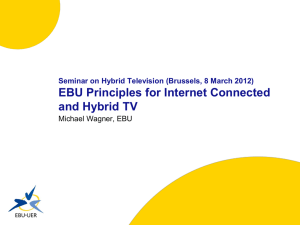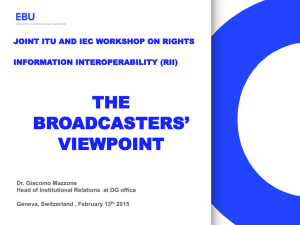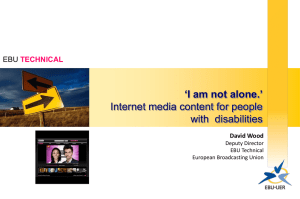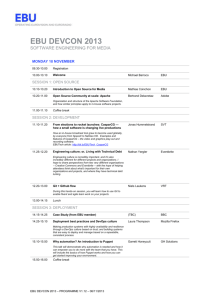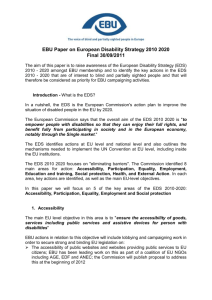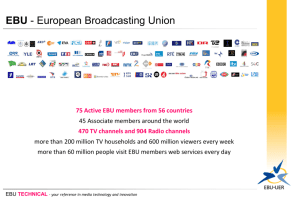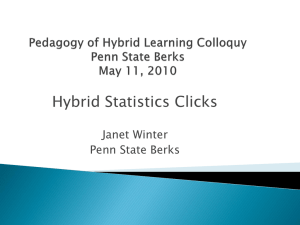Access, competition and transmission issues
advertisement
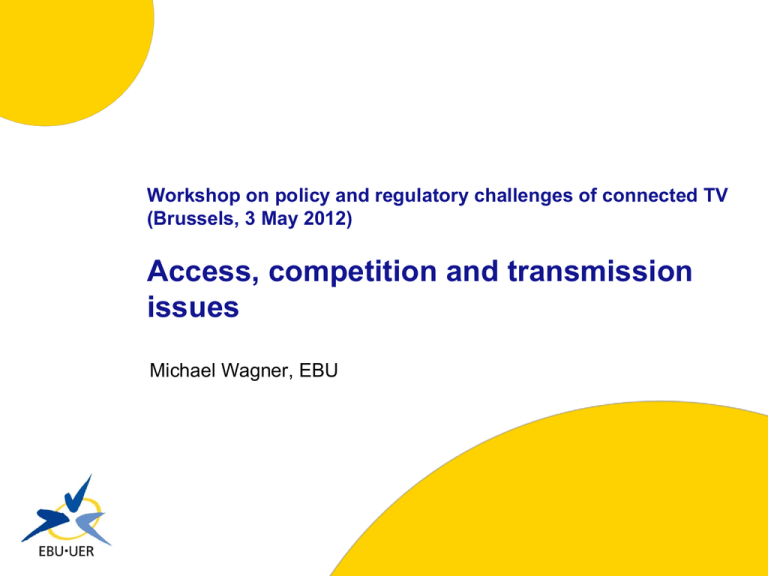
Workshop on policy and regulatory challenges of connected TV (Brussels, 3 May 2012) Access, competition and transmission issues Michael Wagner, EBU First challenge: access issues Broadcasters' content must remain easily findable and accessible for viewers Viewers must be enabled to access any application or portal provided by broadcasters while watching their channels Intermediaries must not destroy the channel experience Providers of hybrid TV portals and other intermediaries must guarantee non-discriminatory access Audiovisual programmes must be properly referenced by media search engines On-demand rights clearance by broadcasters must not be unduly hindered Potential gateways in free-to-air market Transmission platform Broadcast transmission Mainly linear audiovisual content Connected TV device Application signalling Hybrid TV system Broadcaster On-demand rights Application signalling Integrated system? (e.g. iTunes model) IPTV subscription End user Mainly non-linear content Managed Services Walled garden Internet Traffic management Open Internet Hybrid TV portal Media search engine Internet access Access rights Limited legal safeguards exist Telecom law: access to technical networks and certain facilities (APIs) not to content portals/platforms; net neutrality principles Media law: depending on national rules • obligation for network operators to transmit (linear) services ("must carry"), e.g. including application signalling • obligation for platform operators and content aggregators to include (linear or nonlinear) content in their offers, e.g. on HBB portals • presentational aspects of electronic programme guides Competition law: in cases of anti-competitive foreclosure, depending on market power ("essential facilities"); national rules against unfair competition Second challenge: content integrity The quality of the user's viewing experience depends on the integral transmission and authentic display of audiovisual content and services The integrity of broadcasters' content and the economic value of their services must be protected against overlays and other "parasitic" behaviour by third parties Overlays on the television picture should occur only following an active decision by the viewer ("opt-in") While viewers may wish to aggregate content from different sources, there must always be a clear identification of the content source The legal framework to address access, competition and transmission issues Telecom Audiovisual Coherent Platform Regulation ? e-Commerce Competition IPR The legal framework to address access, competition and transmission issues Access to hybrid platforms and portals Telecom Audiovisual Coherent Platform Regulation ? e-Commerce Increased responsibility of intermediaries Access to hybrid systems and devices Competition IPR Restriction of overlays and “parasitic” use of content The EBU Principles for Internet Connected and Hybrid TV ...are based on discussions with broadcasters worldwide - World Broadcasting Unions discussion paper (January 2011) ...are in the form of an EBU policy paper - adopted by the EBU Executive Board in April 2011 ...are meant as a contribution for discussion with other stakeholders (industry, regulators) - not an industry Code of Conduct EBU Members call for all systems to be designed in ways which respect the proposed basic Principles - without prejudice to more detailed or stricter rules at the national level Purpose of the EBU Principles they should allow all stakeholders to seize the opportunities offered by hybrid systems - A common understanding among stakeholders should ease the introduction of hybrid systems they should provide safeguards against potential risks - Measures embedded in the design of hybrid systems - protection by design - are often more effective than ex post intervention - Voluntary alignment would reduce the risk of litigation and the need for regulatory intervention. Thank you The EBU principles are available at: http://www.ebu.ch/en/legal/position/index.php Access issues: different visions (Source: www.google.com/tv) Content integrity: different visions "Yahoo's Connected TV knows what you're watching and can display overlays based on it" (Source: CNET/Yahoo)
